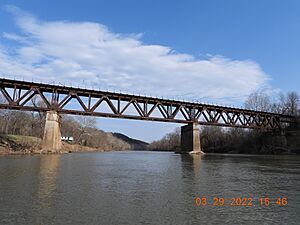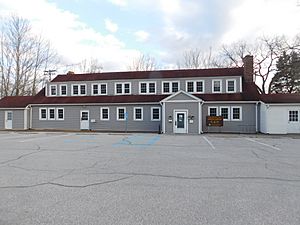Times Beach, Missouri facts for kids
Quick facts for kids
Times Beach
|
|
|---|---|

Times Beach Bridge
|
|
| Country | United States |
| State | Missouri |
| County | St. Louis County |
| Founded | 1925 |
| Dis-incorporated | 1985 |
| Elevation | 436 ft (133 m) |
Times Beach was a small town in St. Louis County, Missouri, in the United States. It was about 17 miles southwest of St. Louis. Once, over two thousand people lived there.
However, the town had to be completely emptied in 1983. This was because the soil was polluted with a very harmful chemical called TCDD, a type of dioxin. This event was the largest time civilians in the U.S. were exposed to this chemical.
In 1985, the state of Missouri officially closed down Times Beach as a city. Today, the area where Times Beach once stood is a 419-acre state park. This park remembers U.S. Route 66, a famous highway that passed by the town. The park opened in 1999. In 2001, the EPA announced that Times Beach was clean and removed it from its Superfund list.
History of Times Beach
Times Beach was started in 1925. It was built on the flat land next to the Meramec River. A newspaper called the St. Louis Star-Times promoted it. If you bought a small piece of land for $67.50, you also got a six-month newspaper subscription!
From Resort to Residential Area
At first, Times Beach was a place where people went for summer vacations. But during the Great Depression and World War II, it became harder for people to travel. So, the town changed into a community with mostly low-income housing. By 1970, about 1,240 people lived there. Before the town was evacuated, it was a lower-middle-class area. There was always a small grocery store and gas station on Route 66 for the residents.
Flooding and the Dioxin Discovery
Times Beach often had floods because it was on a flood plain. Its first buildings were even built on stilts to prepare for this. In December 1982, a very bad flood hit the town. The Meramec River rose more than 14 feet above its normal level.
This flood happened just as the Environmental Protection Agency (EPA) confirmed that the soil was polluted with dioxin. This discovery led to the town being emptied by 1985. By 1992, all the buildings were torn down. On April 2, 1985, Missouri governor John Ashcroft officially closed the city. The story of Times Beach was even shown on the Modern Marvels TV show.
Dioxin Contamination: A Closer Look
The problem in Times Beach started with chemical waste.
How the Contamination Began
Chemical Waste Disposal
In the late 1960s, a company called Northeastern Pharmaceutical and Chemical Company, Inc. (NEPACCO) made chemicals near Verona, Missouri. They produced a chemical called hexachlorophene, which was used in soaps and disinfectants.
During this process, a very toxic chemical called 2,3,7,8-tetrachlorodibenzo-p-dioxin (TCDD), or dioxin, was accidentally made in small amounts. NEPACCO tried to clean their product, but this left behind a thick, oily waste that was full of dioxin. This waste was stored in a tank.
At first, NEPACCO sent this waste to be burned, which was the best way to get rid of dioxin. But it was very expensive. So, they hired another company, Independent Petrochemical Corporation (IPC), to handle the waste. IPC didn't know much about waste disposal, so they hired a local waste oil business owner named Russell Martin Bliss.
Between 1971 and 1972, Bliss collected six truckloads of this dioxin-filled waste. He mixed it with used motor oils at his storage facility. Some of this contaminated oil was then sold to other companies.
First Signs of Trouble
Bliss also owned a horse farm. He sprayed waste oils on his horse arena to keep the dust down. This method worked very well, so other people started hiring him to spray their properties too.
- Shenandoah Stable: On May 26, 1971, Bliss sprayed 2,000 gallons of waste oil at Shenandoah Stable. The oil was thick and smelled bad. Within days, birds died, and horses got sick, losing hair and developing sores. The owners, Judy Piatt and Frank Hampel, blamed Bliss. They removed the top layers of soil, but horses kept getting sick. Eventually, 62 horses died or had to be put down. The owners and their daughters also got sick with headaches, nosebleeds, and stomach problems.
- Other Stables: A month later, Bliss sprayed Timberline Stables. Twelve horses died there, and children exposed to the arena developed chloracne, a skin condition linked to dioxin. Another place, Bubbling Springs Ranch, had similar problems. Owners at both places removed the topsoil. One contractor, Vernon Stout, took the soil to his own property and a neighbor's home instead of a landfill.
Investigations by the CDC
The mysterious illnesses at Shenandoah Stable caught the attention of the Centers for Disease Control and Prevention (CDC). In 1971, they collected samples but couldn't find the exact cause. In 1973, tests showed trichlorophenol, a chemical related to dioxin.
Finally, on July 30, 1974, the CDC found high levels of dioxin in the soil from Shenandoah. Even small amounts of dioxin were known to be deadly to animals. The CDC immediately looked for other contaminated places. Bliss claimed he didn't know where the dioxin came from.
The CDC narrowed their search to companies that used or made trichlorophenol. NEPACCO was the only one that had worked with Bliss. NEPACCO had closed in 1972 after a ban on hexachlorophene. During an inspection, the CDC found a tank with 4,300 gallons of NEPACCO waste, containing very high levels of dioxin.
The CDC advised people living near the Minker and Stout properties to avoid contact with the soil. They also suggested removing and burying the contaminated soil. However, based on an incorrect estimate that dioxin's half-life was only one year, Missouri officials decided not to clean up the sites. Today, we know dioxin's half-life is much longer, between seven and eleven years.
EPA's Involvement and Public Concern
The Environmental Protection Agency (EPA) became heavily involved in 1979. A former NEPACCO employee reported that toxic waste was buried on a farm. The EPA dug up 90 leaky drums, some with dioxin levels as high as 2,000 ppm.
In 1982, the EPA retested the stable and property sites. They found that dioxin levels had not gone down. Some areas still had 1.8 ppm of dioxin, even after eleven years. EPA officials suggested closing the stables and starting cleanup. However, these cleanups were delayed.
The public became very concerned in late 1982. A leaked EPA document listed 14 confirmed and 41 possibly contaminated sites in Missouri. Times Beach was on this list. People were upset that the EPA had not told them about the dangers.
The Crisis at Times Beach
A Double Disaster: Dioxin and Flood
In 1972, Times Beach hired Bliss to spray its 23 miles of dirt roads with waste oil because they couldn't afford to pave them. Over four years, Bliss sprayed about 160,000 gallons of waste oil in Times Beach. The town only learned about the dioxin contamination when the EPA document was leaked in 1982.
The EPA started investigating Times Beach. They collected soil samples on December 3, 1982. The very next day, Times Beach suffered its worst flood ever. The Meramec River overflowed, rising over 14 feet. Residents had to leave their homes. By the time the water went down, the EPA had finished its tests. The results showed dioxin levels as high as 0.3 ppm all along the town's roads.
Government Buyout and Cleanup
On December 23, 1982, the CDC officially recommended that no one should live in Times Beach again. Officials were unsure about the long-term health effects of dioxin exposure. They also worried that future floods would spread the contamination even more.
On January 7, 1983, President Ronald Reagan created a special task force to deal with Times Beach. On February 22, 1983, the EPA announced that the government would pay $33 million to buy out the 800 homes and 30 businesses in Times Beach. The state of Missouri would pay the remaining $3.7 million.
By 1985, all 2,000+ residents of Times Beach had moved away. Governor John Ashcroft then officially closed the town.
Since Times Beach had over half of all the dioxin in Missouri and no one lived there, it was chosen as the site for a new incinerator. Construction began in June 1995. This incinerator burned more than 265,000 tons of dioxin-contaminated materials from all over the state. The cleanup of Missouri was finished in 1997 and cost nearly $200 million.
Legal Actions and New Laws
After the events in Missouri, new laws were created to control how hazardous waste is made and disposed of.
- In 1976, Congress passed the Toxic Substances Control Act. This law requires testing of chemicals that could harm the environment.
- Also in 1976, the Resource Conservation and Recovery Act (RCRA) was passed. It controls the transport and disposal of dangerous waste.
- In 1980, the Comprehensive Environmental Response, Compensation, and Liability Act (CERCLA) was passed. This law created a special fund, called Superfund, to clean up old, abandoned hazardous waste sites.
CERCLA also made companies responsible for environmental damage caused by their toxic substances. In 1983, the government sued NEPACCO. Under CERCLA, NEPACCO had to pay back the government for the cleanup efforts at the farm where they had buried chemical waste.
Russell Martin Bliss was not legally required to keep records of the waste he collected before 1976. He claimed he didn't know the waste contained dioxin. However, many lawsuits were filed against NEPACCO, Syntex Agribusiness, IPC, and Bliss. For example, the owners of Shenandoah Stable settled their lawsuits for significant amounts of money.
What Happened to Times Beach Today?
Even though moving was for their safety, it was a very hard time for the families of Times Beach. They had to leave everything behind. Many worried about money and their children's health. The emotional impact of leaving their homes was huge.
The land where Times Beach once stood is now Route 66 State Park. Only one building from the old town remains: the park's visitor center. It used to be a roadhouse and later served as the EPA's headquarters during the cleanup. There's a large grassy mound in the park, which covers the debris of the demolished town buildings.
In June 2012, the EPA retested the soil at Route 66 State Park. On November 19, 2012, they reported that "Soil samples from Route 66 State Park show no significant health risks for park visitors or workers." This means the park is safe for everyone to enjoy.
Images for kids
See also
 In Spanish: Times Beach para niños
In Spanish: Times Beach para niños




